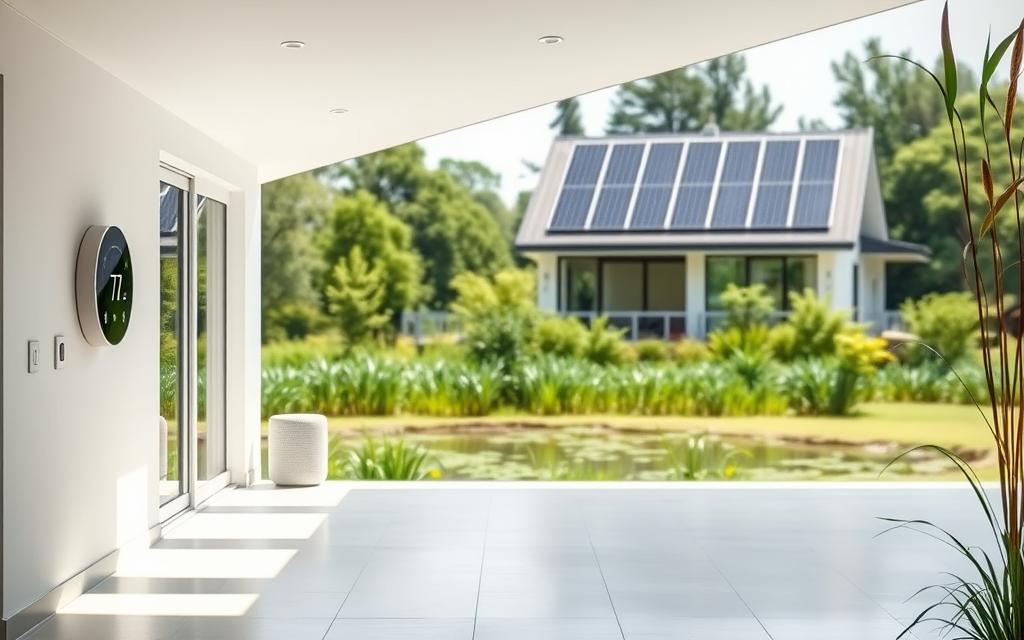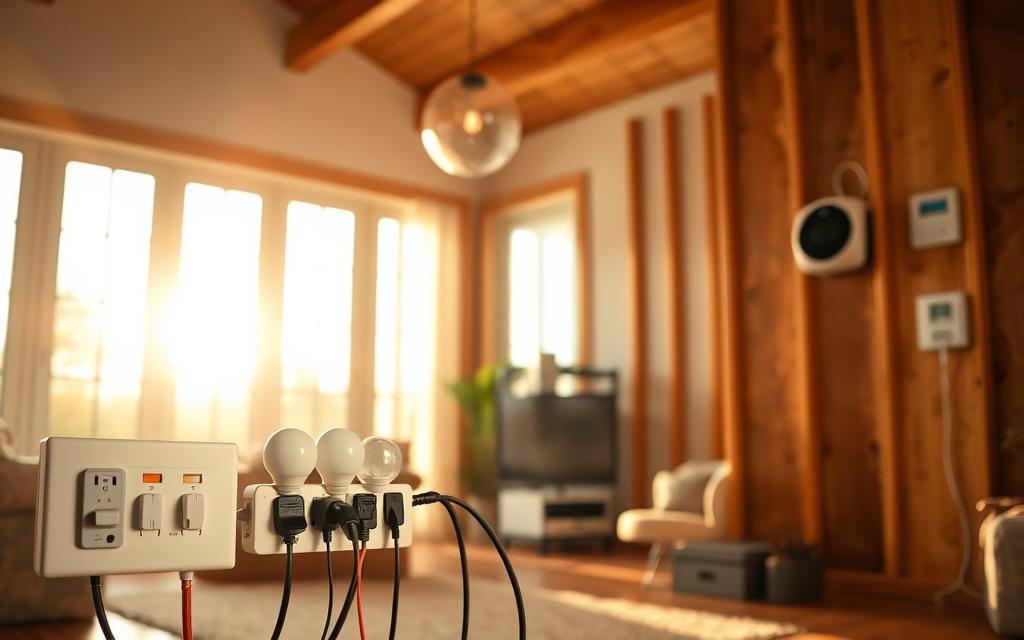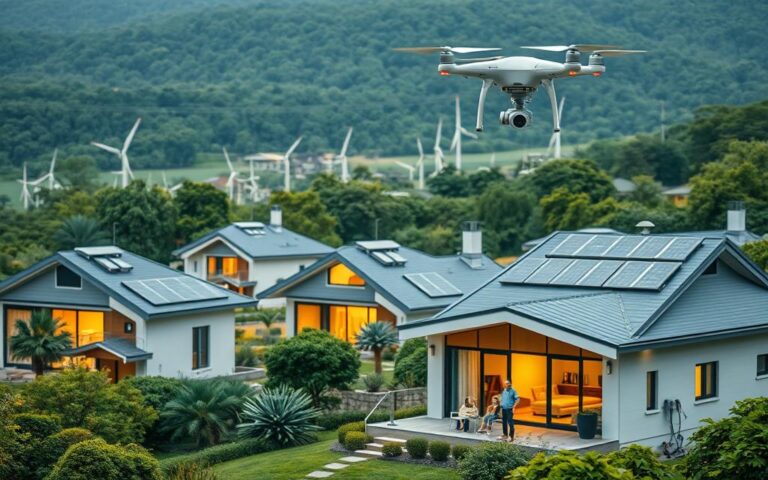Did you know the average American household spends over $2,000 a year on energy bills? Energy costs keep going up, making it crucial to find ways to save. Smart plugs are a great solution to cut down on these costs.
These devices help you keep an eye on and control your energy use. By using smart plugs, you can lower your carbon footprint and save money. The Inflation Reduction Act now offers more ways to get these energy-saving upgrades.
What Are Sustainable Home Upgrades?
Sustainable home upgrades make homes more efficient and kinder to the planet. They improve living spaces and help the environment. These upgrades focus on using energy wisely, lasting longer, and cutting down on carbon emissions.
Introduction to Sustainable Home Improvements
Key parts of sustainable upgrades include using energy-saving appliances and solar panels. These changes help homeowners do their part for the planet. They also save money on energy bills and use less fossil fuels.
Key Features of Eco-Friendly Upgrades
Energy-efficient updates have several important features:
- Durability: Sustainable materials and tech last longer, cutting down on replacements and repairs.
- Energy Savings: Better insulation, windows, and appliances use less energy without sacrificing comfort.
- Carbon Footprint Reduction: Low-emission choices reduce a home’s environmental impact.
Benefits of Eco-Friendly Upgrades
Choosing eco-friendly upgrades can change your home and help the planet. These changes make your home use less energy and save money. They also make your home more comfortable and healthier.
Reducing Energy Consumption
Energy-saving home updates cut down on nonrenewable energy use. Using appliances with the Energy Star label uses less electricity. Solar panels are another great option, providing clean energy and reducing carbon footprint.
Long-term Cost Savings
Going green can save you money in the long run. Although it might cost more upfront, you’ll save on bills later. This lets you save more or make more home improvements. Plus, green homes are more attractive to buyers who care about the environment.
How to Choose the Right Sustainable Upgrades
Choosing the right sustainable upgrades for your home is a big decision. You need to think about your current situation and future goals. By looking at your home’s needs, you can pick the upgrades that will help the most.
It’s important to consider your local climate, how much energy you use, and what resources are available. This helps you make smart choices for your home.
Assessing Your Home’s Needs
First, check out your home’s materials and systems. Look for ways to make your home more energy-efficient. An energy audit can show you where you’re losing energy, like bad insulation or old appliances.
Also, think about your family’s lifestyle and how it fits with your green goals. This will help you choose the right upgrades.
Identifying Key Areas for Improvement
It’s crucial to find the most important areas to improve for sustainable home remodeling. Look for upgrades that will have the biggest positive impact on the environment. Here are some key areas to focus on:
- Insulation Quality: Check your insulation and see if you can upgrade to something more eco-friendly.
- Heating and Cooling Systems: Consider replacing old systems with newer, more energy-efficient ones.
- Water Usage: Find ways to use less water, like installing low-flow fixtures.
- Lighting: Switch to LED and smart lighting to cut down on energy use.
Knowing what needs fixing and what upgrades are best will help you make your home more sustainable.
Financing Your Sustainable Home Upgrades
Many homeowners are looking into financing for sustainable home upgrades. These upgrades make homes more energy-efficient without breaking the bank. Loans and incentives can help cover the costs, making these upgrades more accessible.
Available Loans and Incentives
It’s important for homeowners to know about the financing options for sustainable upgrades. Programs like the HomeStyle Energy Mortgage and GreenCHOICE Mortgage are made for this purpose. They offer favorable terms for borrowing money for energy-saving improvements.
Tax credits and rebates, especially from the Inflation Reduction Act, also help reduce costs. This makes it easier for homeowners to go green.
Federal and State Programs
There are many federal and state programs that offer financial help for sustainable upgrades. Homeowners can find local grants or energy efficiency programs to support greener living. The Department of Energy helps find state-specific programs for tax credits or rebates on energy-efficient upgrades.
These programs are key in encouraging homeowners to make their homes more energy-efficient. They also help reduce the financial burden of these upgrades.
Real-Life Impact of Sustainable Home Upgrades
Adding sustainable upgrades to homes has made a big difference. Homeowners and small businesses have seen the good side of going green. They enjoy better living and working spaces and help the planet too.
Case Study: Household Transformations
Many families have made their homes greener. They’ve cut down on energy use by using efficient appliances and solar panels. One family saw their energy costs drop by 30% in just a year.
This shows how going green can save money and help the environment.
Case Study: Small Business Evolutions
Small businesses have also made big changes by going green. A local café, for example, used LED lights and composted waste. It also started using organic ingredients.
This move not only lowered their bills but also made more customers loyal. It shows how businesses can be profitable and sustainable at the same time.
Integrating with Smart Home Technology
Smart home tech is key to saving energy and making homes more efficient. It lets homeowners track and control energy use easily. This makes homes more eco-friendly and saves money on bills.
Smart Systems for Efficiency
Smart systems in homes boost energy efficiency. Smart thermostats adjust the temperature based on your habits. Energy monitors show how much you’re using, helping you use less.
Benefits of Home Automation
Home automation does more than just make life easier. It helps control energy use, reducing waste. You can set devices to turn on and off remotely or with voice commands. This shows how tech, comfort, and green living go hand in hand.

Analyzing Energy Performance
Understanding energy performance is key when making your home more energy-efficient. Homeowners need to watch how energy use changes after making upgrades. This helps see if the changes are working well and where you can improve more.
Monitoring Energy Use Trends
Smart meters and energy monitoring systems give important data on energy use. They help homeowners see which appliances use the most energy. Regular checks help spot patterns that might be missed. This information guides what energy-saving steps to take next.
Evaluating Upgrades Effectively
Checking how upgrades work is crucial. Homeowners should compare energy bills before and after making changes. This shows if the changes are saving energy and money. It also shows how well each upgrade is doing.
Challenges and Considerations
Homeowners looking into eco-friendly home improvements face several challenges. It’s important to know the potential drawbacks of these upgrades. Costs and finding reliable contractors are key to a successful green renovation.
Cost vs. Benefit Analysis
Before starting eco-friendly home improvements, a cost vs. benefit analysis is key. It helps homeowners see the upfront costs and long-term savings. Even though starting costs may be high, energy-efficient upgrades can save a lot on bills over time.
The table below shows how upfront costs compare to long-term savings for different green upgrades:
| Renovation Type | Upfront Cost | Estimated Annual Savings | Payback Period (Years) |
|---|---|---|---|
| Solar Panels | $15,000 | $1,500 | 10 |
| High-Efficiency HVAC | $5,000 | $600 | 8.3 |
| Energy-Efficient Windows | $8,000 | $400 | 20 |
| LED Lighting | $1,000 | $200 | 5 |
The Need for Reliable Contractors
Finding a trustworthy contractor is crucial for green home renovations. A good contractor can help navigate eco-friendly upgrades. They ensure installations are done right and efficient.
Do your homework on contractors. Check their references and read reviews. This can help avoid costly mistakes and make your upgrades worthwhile.
Conclusion: Making the Change
Choosing sustainable home upgrades is more than saving money on energy bills. It’s also a way to fight climate change. By making your home greener, you can save money and help the planet. Plus, you might inspire others to do the same.
Balancing Cost with Environmental Impact
At first, green upgrades might seem expensive. But, they save money in the long run and are better for the environment. By choosing eco-friendly options, you help the planet and your wallet. This choice can also start a bigger movement towards being green.
Inspiring Others Towards Sustainability
Your efforts to make your home sustainable can encourage others to do the same. Talking about your green home changes can spread the word. This way, you help build a community that cares about the planet.



